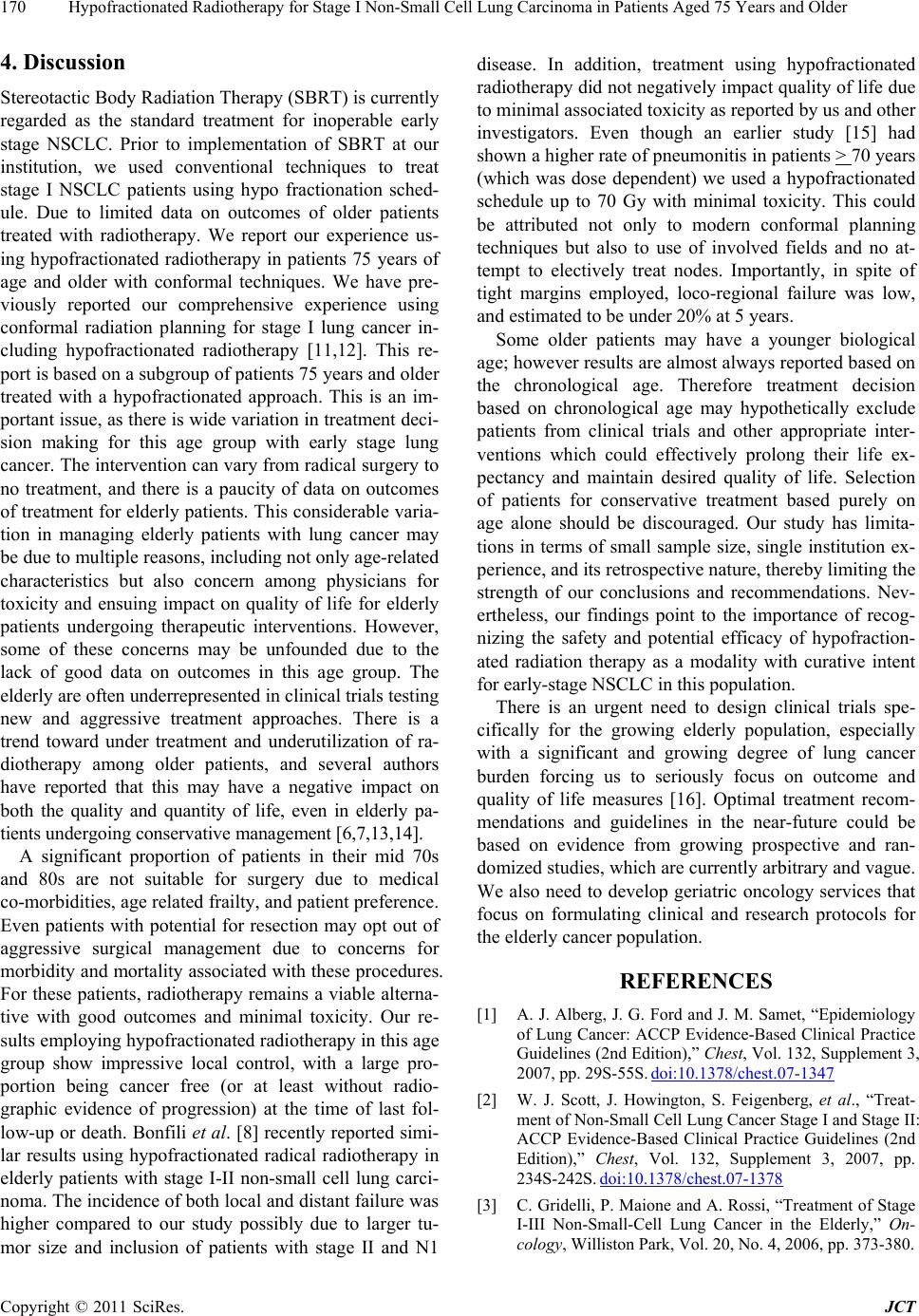
Hypofractionated Radiotherapy for Stage I Non-Small Cell Lung Carcinoma in Patients Aged 75 Years and Older
170
4. Discussion
Stereotactic Body Radiation Therapy (SBRT) is currently
regarded as the standard treatment for inoperable early
stage NSCLC. Prior to implementation of SBRT at our
institution, we used conventional techniques to treat
stage I NSCLC patients using hypo fractionation sched-
ule. Due to limited data on outcomes of older patients
treated with radiotherapy. We report our experience us-
ing hypofractionated radiotherapy in patients 75 years of
age and older with conformal techniques. We have pre-
viously reported our comprehensive experience using
conformal radiation planning for stage I lung cancer in-
cluding hypofractionated radiotherapy [11,12]. This re-
port is based on a subgroup of patients 75 years and older
treated with a hypofractionated approach. This is an im-
portant issue, as there is wide variation in treat ment deci-
sion making for this age group with early stage lung
cancer. The intervention can vary from radical surgery to
no treatment, and there is a paucity of data on outcomes
of treatment for elderly patients. This considerable varia-
tion in managing elderly patients with lung cancer may
be due to multiple reasons, including not only age-related
characteristics but also concern among physicians for
toxicity and ensuing impact on quality of life for elderly
patients undergoing therapeutic interventions. However,
some of these concerns may be unfounded due to the
lack of good data on outcomes in this age group. The
elderly are of ten und err epr esen ted in clin ical trials testing
new and aggressive treatment approaches. There is a
trend toward under treatment and underutilization of ra-
diotherapy among older patients, and several authors
have reported that this may have a negative impact on
both the quality and quantity of life, even in elderly pa-
tients undergoi ng conservative ma nagement [6,7,13,14] .
A significant proportion of patients in their mid 70s
and 80s are not suitable for surgery due to medical
co-morbidities, age related frailty, and patient pr eference.
Even patients with potential for resection may opt out of
aggressive surgical management due to concerns for
morbidity and mortality associated with these procedures.
For these patients, radiotherapy remains a viable alterna-
tive with good outcomes and minimal toxicity. Our re-
sults employing hypofractionated radiotherapy in this age
group show impressive local control, with a large pro-
portion being cancer free (or at least without radio-
graphic evidence of progression) at the time of last fol-
low-up or death. Bonfili et al. [8] recently reported simi-
lar results using hypofractionated radical radiotherapy in
elderly patients with stage I-II non-small cell lung carci-
noma. The incidence of both local an d distant failure was
higher compared to our study possibly due to larger tu-
mor size and inclusion of patients with stage II and N1
disease. In addition, treatment using hypofractionated
radiotherapy did not negatively impact quality of life due
to minimal associated toxicity as reported by us and other
investigators. Even though an earlier study [15] had
shown a higher rate of pn eumonitis in p atients > 70 years
(which was dose dependent) we used a hypofractionated
schedule up to 70 Gy with minimal toxicity. This could
be attributed not only to modern conformal planning
techniques but also to use of involved fields and no at-
tempt to electively treat nodes. Importantly, in spite of
tight margins employed, loco-regional failure was low,
and estimated to be under 20% at 5 years.
Some older patients may have a younger biological
age; however results are almost always reported based on
the chronological age. Therefore treatment decision
based on chronological age may hypothetically exclude
patients from clinical trials and other appropriate inter-
ventions which could effectively prolong their life ex-
pectancy and maintain desired quality of life. Selection
of patients for conservative treatment based purely on
age alone should be discouraged. Our study has limita-
tions in terms of small sample size, single institution ex-
perience, and its retrospective nature, thereby limiting the
strength of our conclusions and recommendations. Nev-
ertheless, our findings point to the importance of recog-
nizing the safety and potential efficacy of hypofraction-
ated radiation therapy as a modality with curative intent
for early-stage NSCLC in this population.
There is an urgent need to design clinical trials spe-
cifically for the growing elderly population, especially
with a significant and growing degree of lung cancer
burden forcing us to seriously focus on outcome and
quality of life measures [16]. Optimal treatment recom-
mendations and guidelines in the near-future could be
based on evidence from growing prospective and ran-
domized studies, which are currently arbitrary and vague.
We also need to develop geriatric oncology services that
focus on formulating clinical and research protocols for
the elderly cancer population.
REFERENCES
[1] A. J. Alberg, J. G. Ford and J. M. Samet, “Epidemiology
of Lung Cancer: ACCP Evidence-Based Clinical Practice
Guidelines (2nd Edition),” Chest, Vol. 132, Supplement 3,
2007, pp. 29S-55S. doi:10.1378/chest.07-1347
[2] W. J. Scott, J. Howington, S. Feigenberg, et al., “Treat-
ment of Non-Small Cell Lung Cancer Stage I and Stage II:
ACCP Evidence-Based Clinical Practice Guidelines (2nd
Edition),” Chest, Vol. 132, Supplement 3, 2007, pp.
234S-242S. doi:10.1378/chest.07-1378
[3] C. Gridelli, P. Maione and A. Rossi, “Treatment of Stage
I-III Non-Small-Cell Lung Cancer in the Elderly,” On-
cology, Williston Park, Vol. 20, No. 4, 2006, pp. 373-380.
Copyright © 2011 SciRes. JCT